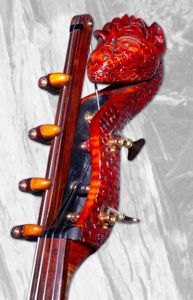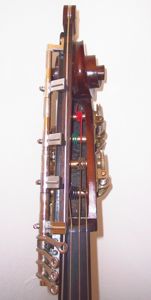| Author | Message | ||
| pauldo
Senior Member Username: pauldo Post Number: 643 Registered: 6-2006 |
www.contrabass.co.uk/2114.htm | ||
| bigredbass
Senior Member Username: bigredbass Post Number: 1730 Registered: 9-2002 |
So I'm supposing this tunes E.A.D.G.C ? J o e y | ||
| adriaan
Moderator Username: adriaan Post Number: 2825 Registered: 6-2002 |
Nope, description clearly states a low B. However, it's an 18th C double bass only very recently converted from a 4 to a 5. | ||
| jacko
Senior Member Username: jacko Post Number: 2972 Registered: 10-2002 |
Wow, that's beautiful. Wonder how much it sold for. Graeme | ||
| dannobasso
Senior Member Username: dannobasso Post Number: 1384 Registered: 3-2004 |
http://en.wikipedia.org/wiki/Octobass | ||
| jimmyj
Advanced Member Username: jimmyj Post Number: 287 Registered: 8-2008 |
Hi friends, For the curious, here's some general bass info I've found, much gleaned from wiki.... Please excuse the lengthy post. The "bass violin" as we know it has been around since the "violin" family of instruments was invented somewhere in 15th century Europe. There was also a "viol" family of instruments, as in viola da gamba, which developed around that time but it seems violin, viola, cello and bass became the more common lineup (maybe just because they were louder!) In the early days I'm sure there were many variations but reportedly the first basses had only 3-strings were built to double the cello an octave lower (unlike that monster two-man job danno linked to above which according to that article could play C0 - TWO octaves below the cello, yikes!). For time reference, Stradavari built his most well-known instruments (Series II?) between 1690-1737. How today's standard tuning came about is a point of contention among historians. The "double-bass" is the only member of the violin family tuned in 4ths, the rest are in 5ths. Some say it's a descendant of the other "viol" family which used tunings closer to guitar; 4ths with a 3rd in the middle. But the physical construction of the bass links it more directly to the violin family. My own personal theory (a-hem!) is that somebody decided the long strings made it impractical to play if tuned in 5ths because of the left hand reach involved in just playing a scale. But that's just my weak guess. However it happened, low-E somehow became the norm. But then composers started writing for lower notes (Strauss's "Also Sprach Zarathustra" written in 1896 starts with the low-C) and so the bass mods began. Here in the US, Canada and the UK, orchestra bassists started adding an "extension" to the E string which allowed the string to continue to the end of the scroll. Here are 3 examples:    The first and simplest version has a lock you can clamp to make an open E and then swing aside and make an open low-C. The problem was if you had to play a low D-flat you really had to reach for it. The second one included individual "fingers" which you could lock to make any of the notes the open string. A practical solution as long as you didn't need to move very fast. Cool scroll on that one too! The third pic is a version often just called a "machine" which added keyed "fingers" on concentric shafts so you could more quickly move between those notes... My dad used this "machine" version for years and then eventually switched to a 5-string setup with a low-B. And I think I remember him saying that Mahler wrote something that called for what he referred to as the "killer-B". A couple other notes here away from the classical side of things... Reportedly in 1966 the late jazz bassist Red Mitchell switched his upright 4-string to a 5ths tuning with a low-C on the bottom. I think there are a handful of guys still playing this way and I'm sure it opens up some interesting possibilities. I'm not too familiar with his work but do remember the great Ron Carter making my ears perk up when he started playing low-Ds. He had added an extension like the first pic above in about 1971 and that's a pretty popular solution now. My brother has that same setup. And that is ALL I know about acoustic bass as I never got my license to operate one in public. HA! Cheers, Jimmy J | ||
| hydrargyrum
Senior Member Username: hydrargyrum Post Number: 1016 Registered: 3-2004 |
Wow! That middle picture is awesome (aside from the technical ramifications). Thanks for sharing! I always enjoy your posts, and feel proud to share your cyberspace. | ||
| bigredbass
Senior Member Username: bigredbass Post Number: 1734 Registered: 9-2002 |
Jimmy: I betcha might know this one: How do they determine if it's a 3/4 or 7/8, etc., upright bass? Scale length? I can NOT imagine what a bowed low B must sound like ! J o e y | ||
| bigredbass
Senior Member Username: bigredbass Post Number: 1735 Registered: 9-2002 |
Oh, and I forgot: One of my best friends routinely played a five-string fiddle (a 'low' C) as he liked being able to ease into viola range. For grins, he'd bow triple-stops IN TUNE. I was always stunned when he'd pull that out, I'd ask him, "HOW do you do THAT?". He'd grin like the cat that ate the canary and say " . . . . like this" and do it again ! J o e y | ||
| jimmyj
Advanced Member Username: jimmyj Post Number: 288 Registered: 8-2008 |
J o e y, From what I understand 3/4 and 7/8 are the most common sizes played. I think it's based on string length and that varies between different makers. Looks like 3/4 size is around 41/42". I saw a 7/8 size listing with 42-1/4" length and a bass described as "big" that had a 45-7/8" scale. That one was strung as a 5 with what must be a great low-B. It is amazing that anybody can play the violin in tune. Look at how close together a mandolin's frets are and then think about doing that on a fretless. Crazy. In my reading today I saw mentioned that sometimes bass soloists will string an upright with a high-C string for intricate upper register stuff (piccolo upright?). Also, I know that Abraham Laboriel Sr. the great LA session guy has a bass with a LOW-F# string below the low-B!! I haven't heard it but it must be absolutely seismic. And how does he tune it, with a watch? Ha! And Jimmy Haslip plays a normally strung bass upside-down and left-handed... So I think the rule is, there is no rule. If you're inspired to try some unusual stringing or tuning setup you should go for it. Jimmy J | ||
| cozmik_cowboy
Senior Member Username: cozmik_cowboy Post Number: 1026 Registered: 10-2006 |
"So I think the rule is, there is no rule. If you're inspired to try some unusual stringing or tuning setup you should go for it." That probably about nails it Jimmy. I remember reading once that Bruce Palmer tuned all 4 strings on his bass to E; sounded OK to me! Peter | ||
| jbybj
Advanced Member Username: jbybj Post Number: 331 Registered: 6-2006 |
I was just at the Musée de la Musique and the Octobass is quite impressive to behold. I took some video and also have a recording that I got at the museum. Once I get it edited I will upload to Youtube. It was a life changing experience. | ||
| pauldo
Senior Member Username: pauldo Post Number: 645 Registered: 6-2006 |
Jimmy - The dragon extension scroll is the cats pajamas! (Message edited by pauldo on July 25, 2011) |